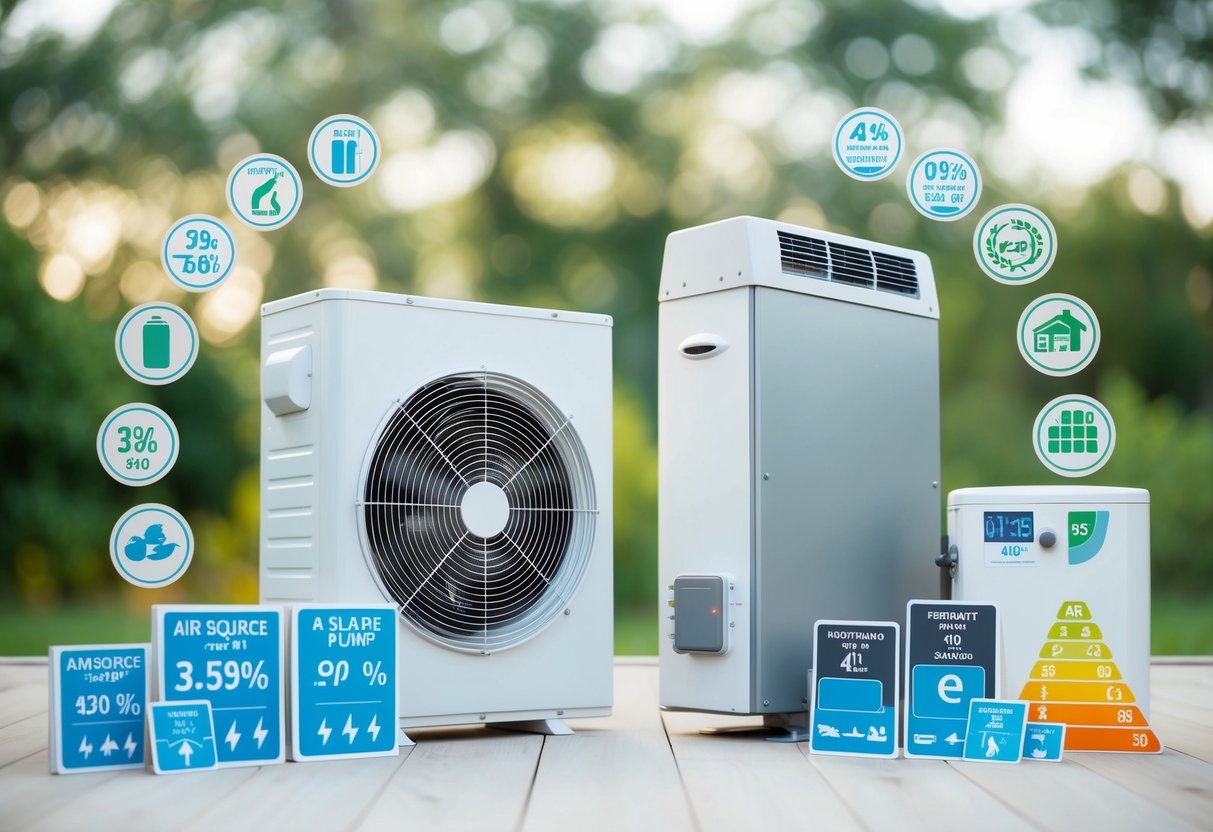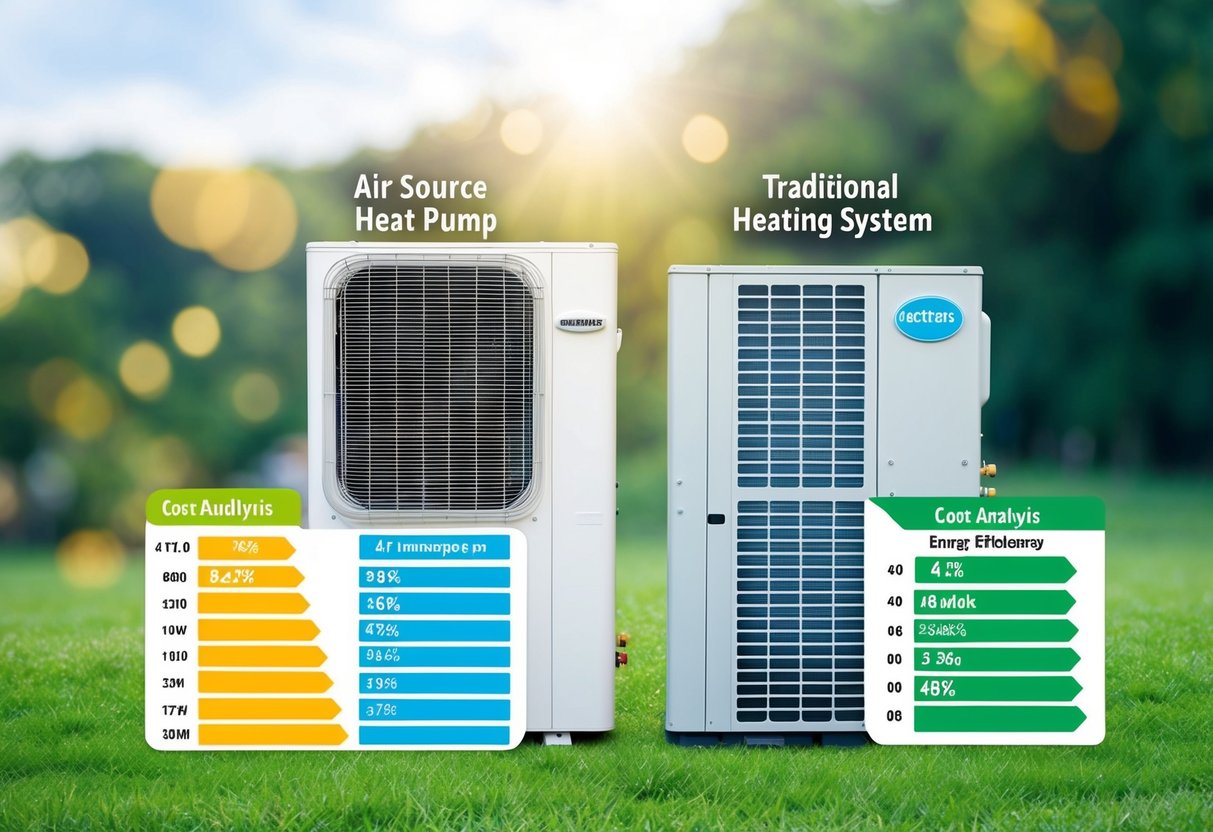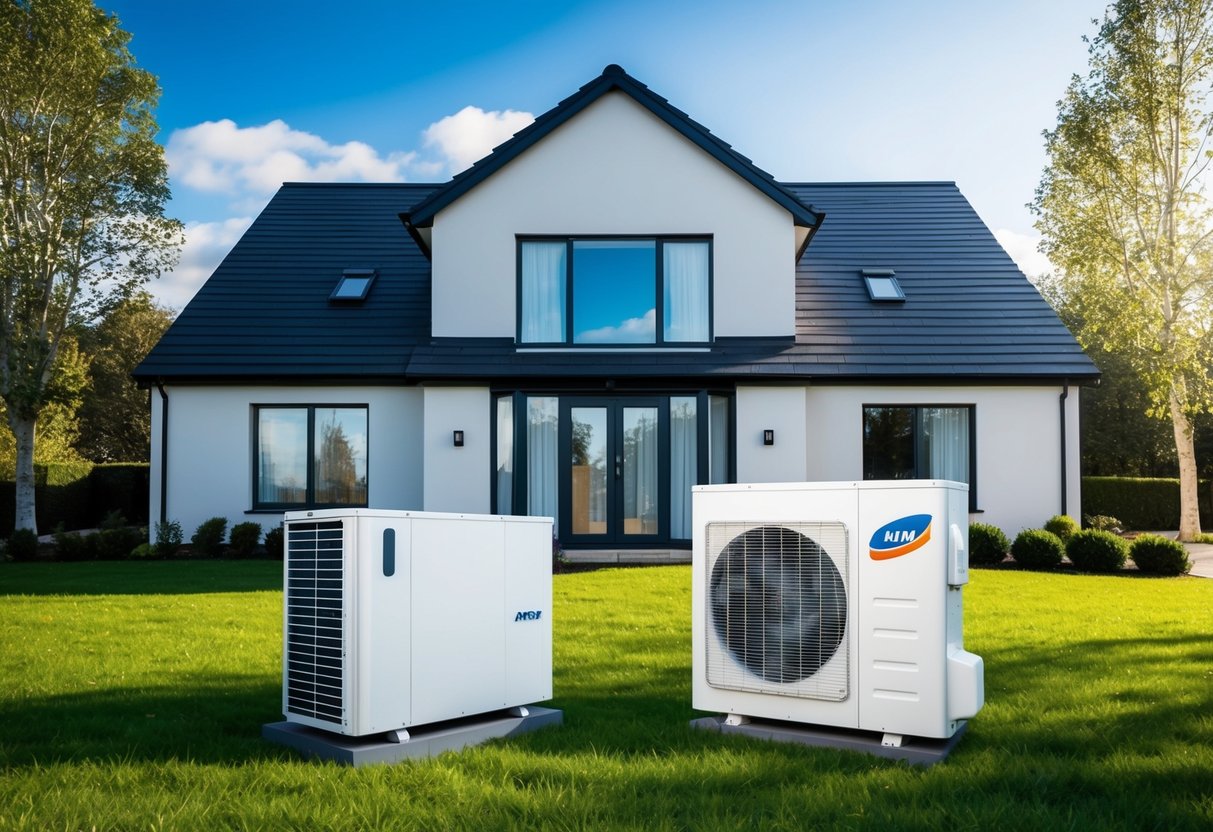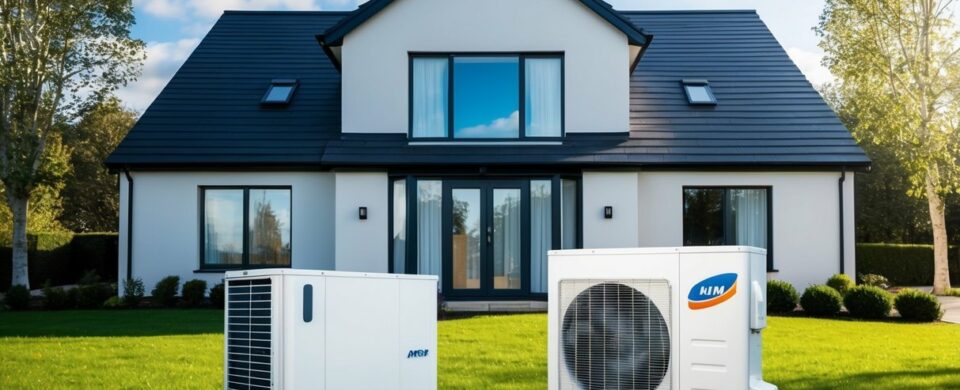Air Source Heat Pumps vs. Traditional Heating: A Clear Comparison of Efficiency
Air source heat pumps are often more energy efficient than traditional heating systems like gas or oil boilers. Some heat pumps can reach efficiencies of 300–400%, meaning they can produce three to four times more heat than the energy they use. In comparison, traditional boilers usually operate below 100% efficiency because they rely on burning fuel.

This difference in efficiency can lead to lower energy bills and reduced carbon emissions for homes with air source heat pumps. People interested in sustainable and cost-effective heating solutions may find that heat pumps offer a modern alternative to older systems.
Choosing between an air source heat pump and a traditional system depends on several factors, including the climate, installation needs, and the type of building. Understanding the main differences can help homeowners make an informed decision about their heating options.
Understanding Air Source Heat Pumps and Traditional Heating

Air source heat pumps and traditional heating systems provide home heating in different ways. Each system has unique methods, components, and advantages that affect efficiency, cost, and installation.
What Are Air Source Heat Pumps?
An air source heat pump (ASHP) is a type of heating system that uses energy from the outside air to heat a home. ASHPs can deliver heat even when the air is cold outside. They work for both heating and cooling, acting much like an air conditioner in reverse during winter.
Most air source heat pumps are installed outside the home. They use electricity to run but often consume less power than systems that create heat from scratch. This can make them more energy efficient.
Common features of air source heat pumps include:
- Quiet operation
- Some models provide hot water
- Can be paired with underfloor heating or radiators
- Work best in well-insulated homes
Types of Traditional Heating Systems
Traditional heating systems rely on burning fuels or using electrical resistance to produce heat. The most common types are:
- Gas boilers: Use natural gas to heat water, which then moves through radiators or underfloor pipes.
- Oil boilers: Burn oil instead of gas to heat water.
- Electric heaters: Use electric currents to generate heat, often in portable or wall-mounted units.
- Storage heaters: Store heat overnight using cheaper electricity and release it during the day.
Traditional systems are often less expensive to install than heat pumps. However, their efficiency may depend on fuel type, system age, and maintenance. Gas and oil systems release carbon dioxide, while electric heaters can be costly to run.
How Do Air Source Heat Pumps Work?
Air source heat pumps work by transferring heat from the outdoor air into the home. They use a refrigeration cycle, similar to a refrigerator or air conditioner, but in reverse.
First, a fan draws in outside air and passes it over a heat exchanger containing refrigerant liquid. The refrigerant absorbs heat, turning it into a gas. A compressor then increases the temperature of this gas. After that, the heat is transferred to the home’s heating system, such as radiators or underfloor pipes.
The process can be up to 3-4 times more energy efficient than direct electric heating, as it moves heat rather than generating it. The main parts of an air source heat pump are:
- Outdoor unit (fan and coil)
- Compressor
- Heat exchanger
- Expansion valve
This process lets heat pumps operate even in cool weather, using less energy than many traditional systems.
Comparing Energy Efficiency

Air source heat pumps and traditional heating systems like gas boilers offer different levels of energy efficiency. Installation quality and the level of home insulation can also have a strong impact on how well these systems perform.
Energy Efficiency of Air Source Heat Pumps
Air source heat pumps (ASHPs) use electricity to move heat from the outside air into a home. Instead of generating heat, they transfer it, allowing them to deliver more energy than they consume. Modern ASHPs typically achieve a Coefficient of Performance (COP) between 3 and 4. This means, for every 1 unit of electricity used, they provide 3–4 units of heat.
Efficiency is affected by the outdoor temperature. ASHPs work best in mild climates but are now effective in cold weather due to recent advances. Compared to gas boilers, they create much less carbon dioxide, especially when paired with renewable electricity.
Ground source heat pumps use energy from the ground rather than air. They tend to be even more efficient but cost more to install.
Typical ASHP Efficiency Table
| System | Typical Efficiency (COP) |
|---|---|
| Air Source Heat Pump | 3.0–4.0 |
| Ground Source Heat Pump | 3.5–4.5 |
Efficiency of Gas Boilers and Other Traditional Systems
Gas boilers burn natural gas to create heat. Their efficiency is usually between 80% and 95%. Modern condensing boilers reach the higher end of this range, but some energy is still lost as waste heat.
Oil boilers and electric resistance heaters are less efficient than gas boilers. Oil boilers often have efficiencies around 85%. Electric resistance heaters convert electricity directly to heat, meaning they have a maximum efficiency of 100%. However, electricity production often depends on fossil fuels, making the overall process less efficient and more polluting than heat pumps.
In most homes, gas boilers offer reliable and consistent heating. However, because they rely on burning fuels, their running costs and emissions are higher compared to most heat pump systems.
The Role of Insulation and Installation Quality
Insulation has a major effect on how efficient any heating system will be. Good insulation helps keep heat inside the home, so both heat pumps and traditional systems need to work less hard. Well-insulated homes can lower energy bills, no matter which heating system is used.
Installation quality is also very important. If a heat pump is not correctly sized or installed, its efficiency drops. The same goes for gas boilers. Poor installation can result in heat loss, uneven room temperatures, and a higher risk of faults.
Homes fitted with an air-to-water heat pump, for example, need larger radiators or underfloor heating to work well. This is because heat pumps operate at lower flow temperatures than gas boilers. Taking insulation and proper installation into account ensures the maximum benefit from any heating system.
Cost Analysis: Installation and Running Costs

Air source heat pumps and traditional gas boilers differ in both upfront and ongoing expenses. Homeowners need to weigh installation costs, long-term energy bills, and available financial support when choosing between the two.
Initial Costs and Installation Considerations
The initial cost of installing an air source heat pump is typically higher than that of a standard gas boiler.
- Air Source Heat Pump: £7,000 – £13,000
- Gas Boiler: £2,000 – £4,500
Air source heat pumps also require outdoor space for the unit and may need upgrades to home insulation or radiator systems. Installation can take longer and may involve additional works, especially in older homes.
Gas boilers are usually easier and quicker to install, especially as replacements for existing units. Most UK homes already have the required infrastructure for a gas boiler, so initial changes are often minimal.
Operating Costs and Energy Bills
The running costs of each system depend on energy prices and efficiency.
A typical gas boiler costs around £984 per year for heating, according to recent data. In contrast, a highly efficient air source heat pump can cost about £723 per year for the same level of heating. These savings are possible because heat pumps can deliver more heat energy than the electrical energy they consume.
Heat pumps use electricity rather than gas. When comparing efficiency, air source heat pumps often outperform older or less efficient gas boilers, especially in homes that are properly insulated. However, energy prices and the efficiency rating of each system will affect actual annual costs.
Government Grants and Incentives
UK homeowners can access government support schemes to help cover the high upfront cost of heat pumps.
The Boiler Upgrade Scheme offers grants (currently up to £7,500) towards the cost of installing an air source heat pump. This incentive can significantly reduce the initial expense and bring the overall cost closer to that of a gas boiler.
These grants are not usually available for gas boilers, making heat pumps more attractive from a financial aid perspective. Additional local incentives might also be available, depending on the region. Always check current eligibility and application requirements before starting any heating system upgrade.
Environmental Impact and Carbon Emissions

Air source heat pumps (ASHPs) and traditional heating systems affect the environment in very different ways. The type of energy used, the amount of carbon produced, and how the systems help with climate goals all impact their overall footprint.
Reducing Carbon Footprint with Air Source Heat Pumps
ASHPs use electricity to move heat from the air outside into homes. They do not burn fossil fuels directly. Because of this, they produce far fewer carbon emissions compared to traditional systems, especially when powered by renewable electricity.
Data from studies shows that installing an air source heat pump can cut a home’s carbon emissions by over 23 tonnes of CO₂ over a decade. Even in cold weather, ASHPs remain highly effective. By using energy from the air, a renewable resource, these systems support a more eco-friendly way of heating.
Homes with ASHPs see their carbon footprint fall, sometimes by more than half, when replacing old gas or oil systems. As national power grids add more solar and wind energy, the carbon savings from heat pumps continue to grow.
Environmental Impacts of Traditional Heating
Traditional heating systems rely on burning fossil fuels like natural gas, oil, or coal. This releases large amounts of carbon dioxide and other pollutants into the air.
For example, a typical gas boiler produces about 2.2 kg of CO₂ per hour of use. Oil and coal systems can emit even more. These emissions add to urban air pollution and make it harder to meet climate targets.
Traditional systems also create extra waste from fuel extraction, transport, and storage. Spills and leaks from oil or gas tanks can harm local soil and water. Over the life of a system, the overall environmental impact is much greater than with air source heat pumps.
Eco-Friendly Heating Options
Heat pumps stand out as a more sustainable choice. Unlike fossil fuel boilers, they do not require direct combustion, so there are no flue gases or soot.
Features of eco-friendly heating with air source heat pumps:
- Use of renewable heat from the environment
- Low direct emissions during operation
- No need for on-site fuel storage
- Can pair with green tariffs or solar panels for even lower emissions
Table: Carbon Emissions per Year for Typical Home Heating
| System | Annual CO₂ Emissions (kg) |
|---|---|
| Gas Boiler | 3,200 |
| Oil Boiler | 3,800 |
| ASHP (average) | 800–1,000 |
These numbers will change based on house size, efficiency, and electricity source, but the gap stays large.
Contribution to Net Zero Goals
The UK has set a target of reaching net zero carbon emissions by 2050. Heating buildings is a major part of national energy use and carbon output.
Air source heat pumps help with this goal by using renewable energy and sharply reducing emissions. As more homes and businesses switch to heat pumps, the share of fossil fuel heating drops, making net zero targets more achievable.
Support from government policies, such as grants and incentives, encourages the move to heat pumps. Lower emissions from ASHPs also help improve local air quality, which is a key goal for many councils and urban areas.
Switching to air source heat pumps is an important step towards cleaner, greener heating across the UK.
Performance, Comfort, and Versatility
Air source heat pumps offer a unique blend of efficiency, comfort, and flexibility. Compared with traditional heating systems, they bring some notable differences in how homes are heated, cooled, and made comfortable throughout the year.
Heating and Cooling Performance
Air source heat pumps work by moving heat from outside air to inside a building, rather than generating heat by burning fuel. This method allows them to work efficiently, especially in mild climates. In many cases, they achieve higher efficiency ratings (COP of 3–4) than gas boilers or electric heaters.
One key advantage is that heat pumps provide both heating and cooling using the same system. In warm weather, they can reverse operation to act as an air conditioner. Most traditional systems, including central heating with gas boilers, only provide heat, which means a separate air conditioning unit is needed for cooling.
While traditional systems can produce gentle or rapid heat depending on type (such as underfloor heating or radiators), air source heat pumps often operate most efficiently at a steady, moderate temperature. This can lead to more consistent indoor temperatures with fewer hot or cold spots. However, in colder climates, the performance of air source heat pumps may fall, requiring a backup heat source during freezing spells.
Year-Round Comfort and Air Quality
Air source heat pumps frequently contribute to a more stable indoor climate. They circulate air continuously when in operation, leading to even temperature distribution. Homes using traditional central heating can sometimes experience uneven heat, especially if rooms are far from the heat source.
Many modern air source heat pumps include filters that help remove dust, pollen, and small particles from the air. This can result in noticeable improvements in indoor air quality compared with some traditional heating systems, such as gas or oil boilers, that do not offer air filtration.
Cooling is also integrated with air source heat pumps, which traditional systems cannot always provide without additional equipment. This dual function supports comfort during both winter and summer, reducing the need for separate units and simplifying overall climate control within the home.
Adaptability to Different Properties
Air source heat pumps can be installed in a wide range of properties, including detached houses, flats, and some commercial buildings. They do not need connection to the gas grid, making them suitable for rural locations.
They work well with different heat distribution systems, including traditional radiators and modern underfloor heating. However, because they operate at lower flow temperatures than gas or oil systems, larger radiators or underfloor heating may be more effective partners.
Traditional heating systems, on the other hand, are generally compatible with existing radiator set-ups. For older homes that are less well insulated, upgrading to an air source heat pump may require extra insulation or changes to the heating circuit to ensure efficient operation.
Lifespan, Maintenance, and Reliability
Air source heat pumps and traditional heating systems differ in how long they last and how much care they need. Most people want a system that is reliable and does not require expensive or frequent repairs.
Expected Lifespan and Durability
Air source heat pumps usually last between 15 and 20 years when properly cared for. Some newer units may reach up to 20 years, which is on par with or slightly better than typical modern gas boilers.
Most traditional gas and oil boilers have a lifespan of about 10 to 15 years. Electric heaters often last about 10 years. Life expectancy can depend on how well the system is maintained and whether it was installed by a qualified technician.
The table below compares average lifespans:
| System Type | Average Lifespan (Years) |
|---|---|
| Air Source Heat Pump | 15–20 |
| Gas Boiler | 10–15 |
| Electric Heater | ~10 |
A long lifespan means fewer replacements and less waste, which can lower costs over time.
Maintenance Needs and Low-Maintenance Options
Air source heat pumps need less maintenance than many traditional systems. Typical care involves checking filters, cleaning coils, and making sure fans and outdoor units are free from leaves and dirt. Yearly professional checks are advised to keep the unit running smoothly.
Gas and oil boilers often need a yearly service, which includes cleaning, checking for leaks, and inspecting pressure levels. Regular care is key for safety, especially with gas systems. Electric heaters, while simple, may still need checks for electrical safety.
A heat pump’s low-maintenance design appeals to homeowners who want a system that can be left alone most of the year. This can reduce hassle and help avoid unexpected repair costs. Proper installation by a certified technician also improves reliability and helps extend the system’s lifespan.
Emerging Technologies and Future Trends
Recent developments in heating systems focus on greater energy savings and environmental benefits. Innovations in heat pump technology and their ability to work with renewable energy are changing how households manage energy prices and sustainability.
Hybrid Heat Pumps and Air Source Innovations
Hybrid heat pumps combine an air source heat pump with a traditional gas boiler or other heating method. The system switches between electric and gas operation based on which is more efficient, helping to reduce energy usage and costs. This is useful in areas with changing energy prices or very cold weather.
Recent air source heat pumps now use improved refrigerants that are better for the environment and increase efficiency. Many new models feature quieter fans and noise-reduction designs, making them more comfortable for homes in busy areas.
Manufacturers are producing smart heat pumps with built-in sensors and controls. These can adjust heating output to match outside temperatures automatically, helping users lower energy bills and respond to the UK’s drive for lower carbon emissions.
Integration with Renewable Energy Systems
Air source heat pumps are increasingly being installed alongside solar panels. Homes with both technologies can use solar electricity to power the heat pump, reducing dependence on the grid and increasing energy savings.
Some modern heat pumps are designed to work directly with on-site battery storage. This allows excess solar energy to be stored during the day and used for heating in the evening or on cloudy days.
These integrated systems help households manage energy prices by reducing the amount of electricity bought from suppliers. Using more renewable energy also lowers emissions further, making home heating more sustainable.
Please Contact Us for advice

